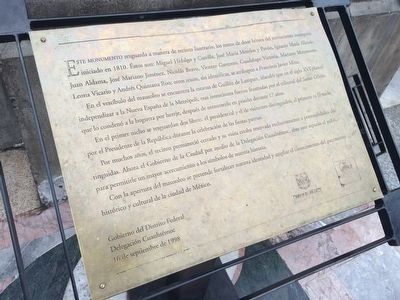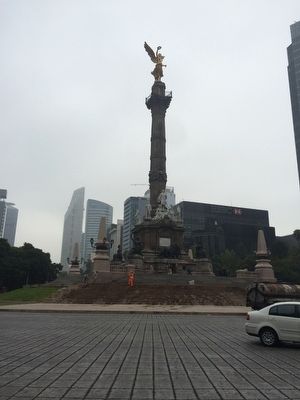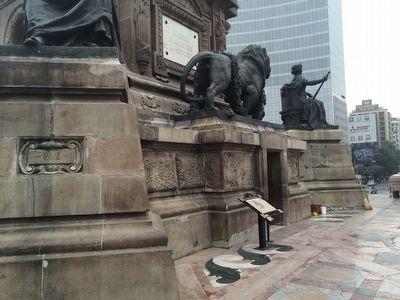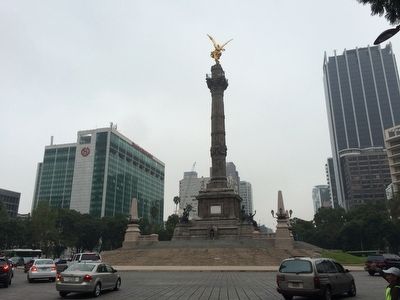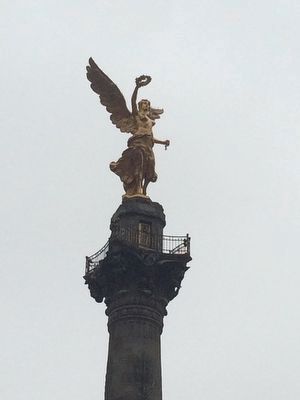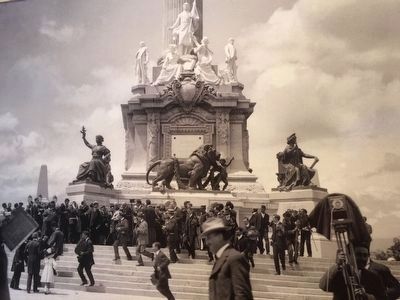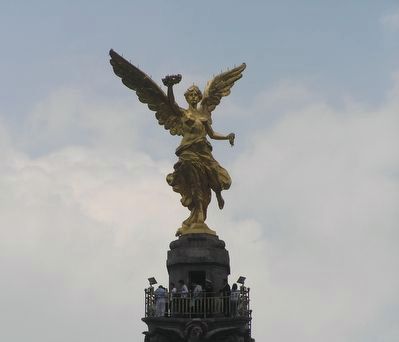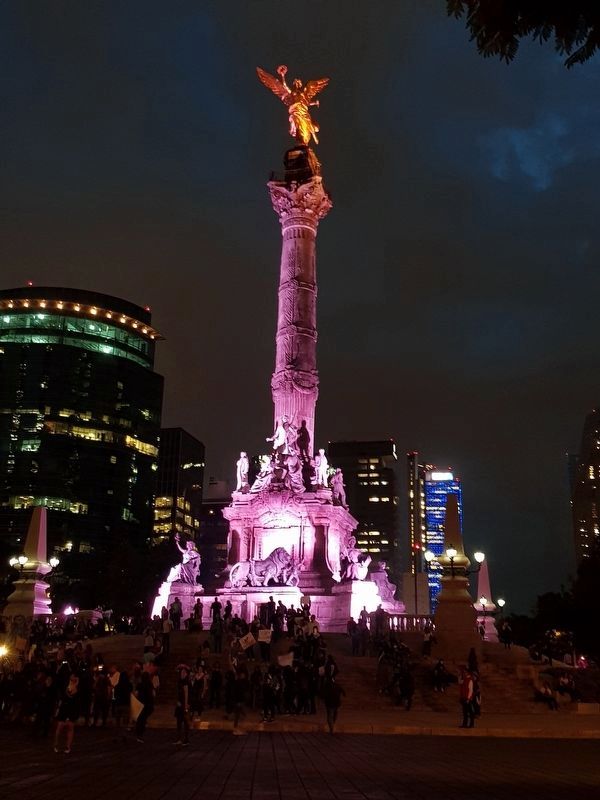Colonia Juárez in Ciudad de México, Mexico — The Valley of Mexico (The Central Highlands)
Monument to Mexican Independence
Monumento a la Independencia Mexicana
— Ángel de la Independencia —
Este monumento reguarda a manera de recinto funerario, los restos de doce héroes del movimiento insurgente iniciado en 1810. Estos son: Miguel Hidalgo y Costilla, José María Morelos y Pavón, Ignacio María Allende, Juan Aldama, José Mariano Jiménez, Nicolás Bravo, Vicente Guerrero, Guadalupe Victoria, Mariano Matamoros, Leona Vicario y Andrés Quintana Roo; otros restos, sin identificar, se atribuyen a Francisco Javier Mina.
En el vestíbulo del mausoleo se encuentra la estatua de Guillén de Lampart, irlandés que en el siglo XVII planeó independizar a la Nueva España de la Metrópoli; esas intenciones fueron frustrados por el tribunal del Santo Oficio, que lo condenó a la hoguera por hereje, después de mantenerlo en prisión por 17 años.
En el primer nicho se resguardan dos libros: el presidencial y el de visitantes distinguidos; el primero es firmado por el Presidente de la República durante la celebración de las fiestas patrias.
Por muchos años, el recinto permaneció cerrado y su visita estaba reservada exclusivamente a personalidades distinguidas. Ahora el Gobierno de la Ciudad por medio de la Delegación Cuauhtémoc, abre este espacio al público para permitirle un mayor acercamiento a los símbolos de nuestra historia.
Con la apertura del mausoleo se pretende fortalecer nuestra identidad y ampliar el conocimiento del patrimonio histórico y cultural de la ciudad de México.
Gobierno del Distrito Federal
Delegación Cuauhtémoc
16 de septiembre de 1998
This monument is a burial site, guarding the remains of twelve heroes of the Mexican revolutionary insurgency began in 1810. These are: Miguel Hidalgo y Costilla, Jose Maria Morelos y Pavón, Maria Ignacio Allende, Juan Aldama, José Mariano Jiménez, Nicolás Bravo, Vicente Guerrero, Guadalupe Victoria, Mariano Matamoros, Leona Vicario and Andrés Quintana Roo; other unidentified remains have been attributed to Francisco Javier Mina.
In the lobby of the mausoleum there is a statue of Lampart Guillen, an Irishman who, in the seventeenth century, planned to make New Spain (Mexico) independent from Spain. These intentions were thwarted by the tribunal of the Inquisition, who sentenced him to the stake for heresy, after keeping him in prison for 17 years.
In a sheltered niche are kept two books: the presidential book and one for distinguished visitors; The first is signed by the President during the celebration of national holidays.
For many years, the inside of the monument remained closed
and visits were reserved exclusively for distinguished personalities. The City Government, through the Cuauhtemoc Delegation, opens this space to enable the public to be closer to the symbols of our history.
The opening of the mausoleum is intended to strengthen our identity and expand knowledge of the historical and cultural heritage of the city of Mexico.
Federal District
Cuauhtemoc Delegation
September 16, 1998
Erected 1998 by Federal District of Mexico and Cuauhtémoc Delegation.
Topics. This memorial is listed in these topic lists: Cemeteries & Burial Sites • Government & Politics • Patriots & Patriotism • Wars, Non-US. A significant historical year for this entry is 1810.
Location. 19° 25.622′ N, 99° 10.053′ W. Marker is in Ciudad de México. It is in Colonia Juárez. Memorial is on Paseo de la Reforma. Touch for map. Marker is in this post office area: Ciudad de México 06500, Mexico. Touch for directions.
Other nearby markers. At least 8 other markers are within walking distance of this marker. Miguel Ramos Arizpe (about 150 meters away, measured in a direct line); Juan Antonio de la Fuente (about 180 meters away); Juan José de la Garza (approx. 0.3 kilometers away); General Pedro J. Méndez (approx. 0.3 kilometers away); Francisco M. S. de Tagle (approx. 0.4 kilometers away); General Ignacio López Rayón
(approx. 0.4 kilometers away); Dr. Carlos Canseco González (approx. half a kilometer away); Ramón Carmona (approx. half a kilometer away). Touch for a list and map of all markers in Ciudad de México.
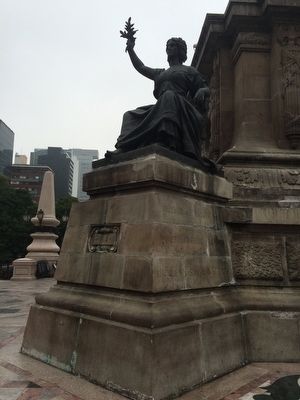
Photographed By J. Makali Bruton, October 26, 2015
5. Monument to Mexican Independence Marker
"Paz" (Peace), one of four allegorical statues that surround the monument. Inscribed on the stonework at the base of the statue are the following names of other important leaders of Mexican Independence: Melchor de Talamantes, F[rancisco] Primo Verdad y Ramos, Marques de San Juan de Rayas, Pedro Ascencio, José Joaquín de Herrera and Miguel Barragán.
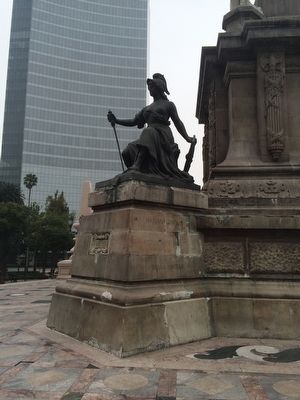
Photographed By J. Makali Bruton, October 26, 2015
6. Monument to Mexican Independence Marker
"Guerra" (War), one of four allegorical statues that surround the monument. Inscribed on the stonework at the base of the statue are the following names of other important leaders of Mexican Independence: Mariano Jiménez, Leonardo Bravo, Pedro Moreno, José Antonio Torres, Victor Rosales and Encarnación Ortiz.
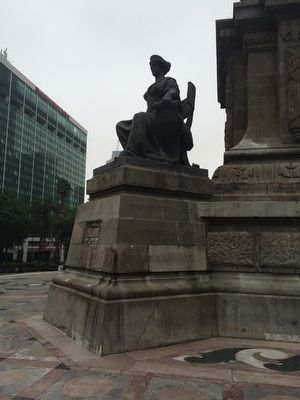
Photographed By J. Makali Bruton, October 26, 2015
7. Monument to Mexican Independence Marker
"Justicia" (Justice), one of four allegorical statues that surround the monument. Inscribed on the stonework at the base of the statue are the following names of other important leaders of Mexican Independence: Servando Teresa de Mier, J. Fernandez de Lizardi, Carlos M. Bustamante, José María Cos, José María Liceaga and Andrés Quintana Roo.
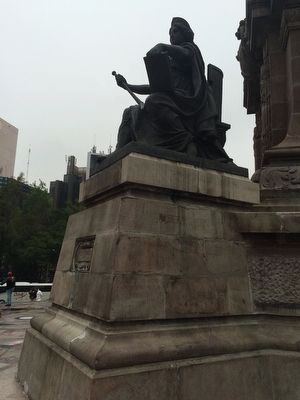
Photographed By J. Makali Bruton, October 26, 2015
8. Monument to Mexican Independence Marker
"Ley" (Law), one of four allegorical statues that surround the monument. Inscribed on the stonework at the base of the statue are the following names of other important leaders of Mexican Independence: Josefa Ortiz, Leona Vicario, Mariana Rodríguez, J. M. de Michelena, Epigmenio González and Antonio Ferrer.
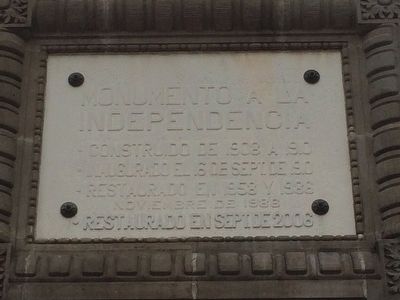
Photographed By J. Makali Bruton, October 26, 2015
9. Monument to Mexican Independence Marker
This additional marker on the reverse of the monument reads: "Monumento a la Independencia, Construido de 1908 a 1910, Inaugurado el 16 de Sept. de 1910, Restaurado en 1958 y 1986, Noviembre de 1986, Restaurado en Sept. de 2006" (Monument to Independence, Constructed from 1908 to 1910, Inaugurated Sept. 16, 1910, Restored in 1958 and 1986, November 1986, Restored in Sept. 2006).
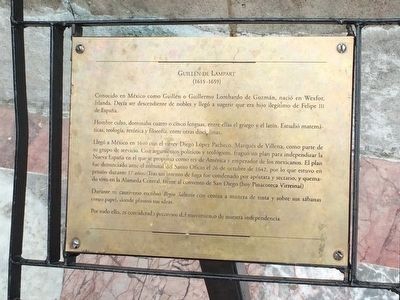
Photographed By J. Makali Bruton, October 26, 2015
10. Monument to Mexican Independence Marker
This additional marker reads: Guillén de Lampart (1615-1659), Conocido en México como Guillén o Guillermo Lombardo de Guzmán, nació en Wexfor, Irlanda. Decía ser descendiente de nobles y llegó a sugerir que era hijo ilegítimo de Felipe III de España. Hombre culto, dominaba cuatro o cinco lenguas, entre ellos el griego y el latín. Estudió matemáticas, teología, retórica y filosofía, entre otras disciplinas. Llegó a México en 1640 con el virrey Diego López Pacheco. Marqués de Villena, como parte de su grupo de servicio. Con argumentos políticos y teológicos, fraguó un plan para independizar la Nueva España en el que se proponía como rey de América y emperador de los mexicanos. El plan fue denunciado ante el tribunal del Santo Oficio el 26 de octubre de 1642, por lo que estuvo en prisión durante 17 años. Tras un intento de fuga fue condenado por apóstata y sectario, y quemado vivo en la Alameda Central, frente al convento de San Diego (hoy Pinacoteca Virreinal). Durante su cautiverio escribió Regio Salterio con ceniza a manera de tinta y sobre sus sábanas como papel, donde plasmó sus ideas. Por todo ello, es considerado precursor del movimiento de nuestra independencia. (English translation: Lampart Guillen (1615-1659), known in Mexico as Guillen Lombardo or Guillermo Guzman, born in Wexfor, Ireland. He claimed to be a descendant of nobles and even suggested that he was an illegitimate son of Philip III of Spain. An educated man, he spoke four or five languages, including Greek and Latin. He studied mathematics, theology, rhetoric and philosophy, among other disciplines. He arrived in Mexico in 1640 with Viceroy Diego Lopez Pacheco, Marqués de Villena, as part of his service group. With political and theological arguments, he hatched a plan to make New Spain (Mexico) independent, in which he intended to be king of the Americas and emperor of Mexico. The plan was reported to the court of the Holy Office on October 26, 1642, and he was put in prison for 17 years. After an escape attempt, he was convicted as an apostate and heretic, and burned alive in the Alameda Central, opposite the convent of San Diego (now Pinacoteca Virreinal). During his captivity he wrote Regio Salterio with ash as ink and bedsheets as paper where he wrote out his ideas. Therefore, he is considered as the precursor of our independence movement.)
Credits. This page was last revised on October 22, 2021. It was originally submitted on October 28, 2015, by J. Makali Bruton of Accra, Ghana. This page has been viewed 480 times since then and 10 times this year. Photos: 1. submitted on October 28, 2015, by J. Makali Bruton of Accra, Ghana. 2, 3, 4, 5, 6, 7, 8, 9, 10, 11. submitted on October 29, 2015, by J. Makali Bruton of Accra, Ghana. 12. submitted on November 4, 2015, by J. Makali Bruton of Accra, Ghana. 13. submitted on October 4, 2018, by J. Makali Bruton of Accra, Ghana. 14. submitted on August 26, 2019, by J. Makali Bruton of Accra, Ghana.
